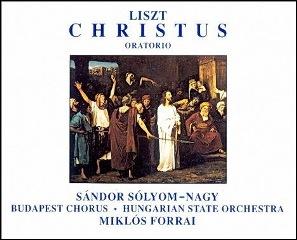Franz Liszt – Christus Oratorio (Forrai)
Franz Liszt – Christus Oratorio (Forrai)

CD1. Christmas Oratorio (Representing Christ’s birth) 1. Introduction (Rorate coeli) (15:54) 2. The pastorale and annunciation of the angels (Angelus ad pastores ait) (7:26) 3. Stabat Mater speciosa (The beautiful Mother stood), hymn (11:06) 4. Song of the shepherds at the manger (14:54) 5. The three holy kings, march (13:46) CD2. After Epiphany (The principal events in Christ’s life) 1. The Beatitudes (Beati pauperes spiritu) (10:38) 2. The Lord's prayer (Pater noster) (7:15) 3. The foundation of the church (Tu es Petrus) (5:50) 4. The miracle (Et ecce motus magnus) (7:37) play 5. The entry into Jerusalem (Hosanna!) (14:46) CD3. Passion and Resurrection (Devoted to Christ’s passion and resurrection) 1. Tristis est anima mea (Sorrowful is my soul) (10:02) 2. Stabat Mater dolorosa (The grieving Mother stood) (28:39) 3. O filii et filiae (O, sons and daughters), Easter hymn (2:23) 4. Resurrexit! (He has risen!) (7:12) Sándor Sólyom-Nagy (Christus, baritone) Éva Andor (soprano) Zsuzsa Németh (mezzo-soprano) József Réti (tenor) József Gregor (bass) Lajos Básti (reciter) Budapest Chorus Hungarian State Orchestra Sándor Margittay (organ, harmonium) Miklós Forrai, conductor – 1980
In 1847 Liszt published a set of orchestral tone poems which were based on poetry and drama. They were brilliant, colourful orchestral showpieces, written in a style derived to a degree not yet generally appreciated from Rossinian operatic interludes and overtures, which in turn leaned a bit on Beethoven Overtures and Symphonies. In 1866 Liszt compiled an oratorio Christus from materials, some begun 13 years earlier, utilising chorale settings of Latin Catholic devotional poems, interspersing them with another kind of tone poem. These tone poems were, like the previous ones, about 15 to 20 minutes long each, and were based on extra-musical subjects. But where the previous set was generally loud and full of storm and stress, battle and victory, these new ones were more reflective, even calm, at times brilliant, at times meditative, yet scored for full orchestra. At some moments we hear Beethoven’s Missa Solemnis, at others Berlioz’s L’Enfance du Christ, and even a hint of Liszt’s own Les Préludes. These reflective tone poems feature a similar postponed resolution of chords, a similar drawn out anguish to that featured in Wagner’s Tristan, and although nobody would play Christus, they would use the music to embarrass Wagner, to accuse him of plagiarism. A few late 19th Century French composers wrote religious works clearly influenced by Christus, and indeed it was a French Catholic acquaintance who had studied the work in score who was most particularly gratified when the first recording finally appeared. --- Paul Shoemaker, musicweb-international.com








